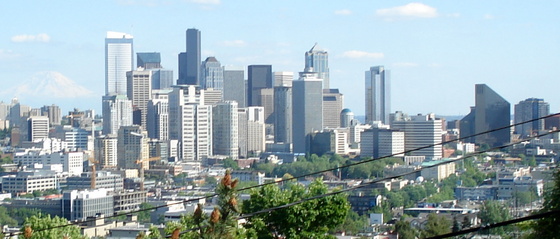This week Cornichon looks at Washington's fourth-largest industry: tourism.
Business travel accounts for only ten percent of tourism traffic to Seattle. Leisure travel is the name of the game. Half the visitors to Seattle arrive by air, a full 20 percent come from outside the country. Sure, half of all travelers come to visit friends and family and don't stay in hotels, but they go out to eat, too; they visit museums and attend local theatrical productions. The Picasso show at SAM last year generated $66 million for Seattle; half the museum-goers were from out of town. The last King Tut show, at the Pacific Science Center, was 30 years ago; it's coming back for a nine-month run next May and already has local hotels and restaurants salivating at the anticipated million visitors the Boy King will attract.
There's also a Gauguin exhibit coming to the Seattle Art Museum, and a big push this year, a new team effort by the Convention & Visitors Bureau and the Washington Wine Commission, to promote Taste of Washington at the end of March.
"If we're going to compete with other west coast cities, we've got to spend more," says Burgess. Los Angeles and Vancouver, BC, spend the most, $12 million a year to promote themselves as a vacation destinations. Seattle, Portland, and Anaheim (Disneyland) spend about $8 million each. But on a statewide basis, nothing.
True to the new economics, now that government has abdicated its responsibility, walked away from the table, the private sector has stepped in. The Washington Tourism Alliance was created earlier this year, bringing together the players with a direct stake in the tourism industry.
And now, to bolster shoulder-season and off-season travel, a coalition of 41 Seattle hotels has started adding a $2 per room-night tax. Not your neighborhood bed & breakfasts, but hotels with more than 60 rooms. Much as a neighborhood might create a Local Improvement District, the hotels have created a Tourism Improvement Area. The tax, which the city collects, is expected to generate $30 million a year. Having passed all the statutory hurdles, the new tax has been in effect November 1st.
As Darryl Brian of Clipper Vacations pointed out, the competition isn't the Coho or Washington State Ferries, it's other destinations.
Surveying the damage here in Washington, a Seattle travel writer named Charyn Pfeuffer tried to start an interactive website called GoWAState.com to promote Washington tourism, but the $50,000 project raised only $350. More successful was the Washington Tourism Alliance, which has a statewide board of directors from a variety of fields (lodging, transportation, wineries, government). Longtime travel pro Suzanne Fletcher was named executive director last month. For now, the privately funded WTA has taken over the official functions of Washignton's tourism agency. Fletcher has a two-year window to work out not just a funding mechanism that doesn't put the whole financial burden on hotels, but also a marketing plan that makes efficient use of a limited budget.
On the national level, there's a similar effort. In the past ten years, the US, as a destination for international travelers, has lost 17 percent of its popularity, and in attempt to make up lost ground, the former Corporation for Travel Promotion has been renamed "Brand USA," complete with an attractive website.
By themselves, ads that feature mountain goats or powder snow or Mickey Mouse don't get people making plans to visit specific destinations. Another important piece of the marketing plan is known as "fam tours," trips to the region for both tourism professionals (who have to know the destination in order to sell its attractions) and for journalists. Some travel agents and writers treat fam tours as junkets or free vacations, but serious journalists and professional travel agents recognize the important advantages of feet-on-the-ground research.
The Seattle TIA will have $6 million a year, give or take, to spend on tourism promotion. Their first effort, now underway, is a campaign to bring visitors from major cities around the Northwest to Seattle for the holiday shopping season, an effort undertaken in conjunction with the Downtown Seattle Association and Seattle Center. It's called a moving billboard, like a snow globe on a truck, and it's making the rounds in Vancouver, BC., Spokane and Portland, while "ambassadors" hand out brochures promoting Seattle as a shopping destination for the holiday season. So far, says Tom Norwalk, results are encouraging.
On the east side of the mountains, legislators are skeptical about assessments to promote the tourism industry. "I don't think you can expect the state to put an assessment tax on anybody," said state Rep. Norm Johnson, R-Yakima, told the Associated Press in relation to a proposed statewide tourism levy. There's a sentiment that tourism benefits only the Seattle economy, and ignores the fact that big cities are the gateway to rural attractions, that rural areas are actually more dependent on tourism than the more vibrant, economically diversified big cities. (Assessments to promote agriculture don't seem to have the same problem; the state's wine industry just voted a self-assessment to help launch a wine science center on the WSU campus in Richland.) Perhaps the Washington legislature feels tourism is "expendable." Perhaps they would trade Ichiro and Felix because the Mariners and losing.
Tomorrow's final installment will look at what happens when a country like Italy stops spending on tourism promotion.

Leave a comment